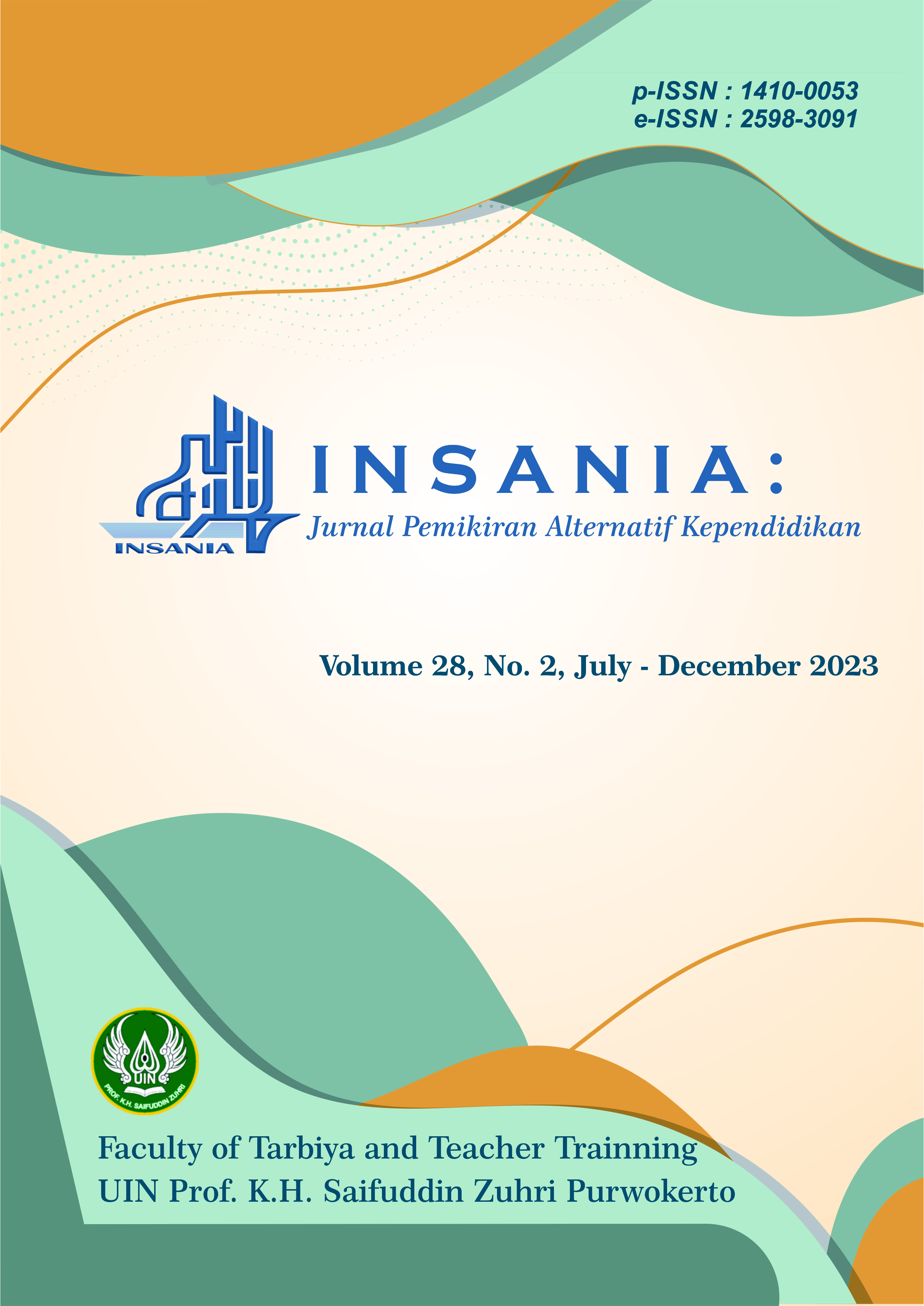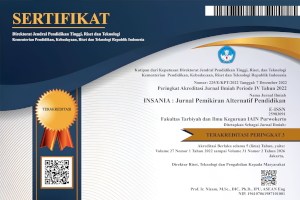Kitab kuning’s existence in the history of Islamic education and its relevance to modern Islamic society in Aceh
DOI:
https://doi.org/10.24090/insania.v28i2.9158Keywords:
Aceh, history, Islamic education, kitab kuningAbstract
This study aims to explain the role of kitab kuning (classic Islamic books) in the treasures of Islamic religious education in Indonesia, so that it can be seen as one of the many influential aspects in the formation of educational discourse in Indonesia. It is carried out in a qualitative descriptive method that is directed to see the scientific discourse of Islamic education and the history of education. Data collections were carried out through literature studies employing historical approach to understand the historical context, changes, or evolution of thoughts or concepts as well as a comparative observation. The data obtained formed an analysis of traditional education discourse, its relevance in history and how the position of kitab kuning in modern education these days. The result of study shows that modern Islamic education today seems unable to abandon kitab kuning as a basic methodology in understanding Islam. There is a phenomenon of increasingly inclusive study of the new format of digitized kitab kuning, not only in pesantren but also in universities. This leads to the synthesis that kitab kuning is potential to be a general learning particularly with the increasingly open dissemination of Islamic literacy. The results of the present study are expected to be able to contribute to the education and teaching system.Downloads
References
Amiruddin, M. H. (2008). Menatap Masa Depan Dayah di Aceh. Yayasan Pena.
Asad, T. (1993). Genealogies of Religion, Discipline and Reasons of Power in Christianity and Islam. The John Hopkins University Press.
Azra, A. (1999). Pendidikan Islam: Tradisi dan Modernisasi Menuju Millenium Baru. Logos.
Azra, A. (2006). Jaringan Ulama. Kencana Prenada Media.
Badi’ah, S., Salim, L., & Syahputra, M. C. (2021). Pesantren dan Perubahan Sosial pada Era Digital. Analisis: Jurnal Studi Keislaman, 21(2), 249–264. https://doi.org/10.24042/ajsk.v21i2.10244
Baso, A. (2018). Sejarah Lahirnya Pesantren Berdasarkan Naskah Babad Cirebon Koleksi Perpustakaan Nasional Republik Indonesia. Jumantara, 9(1), 1–31. https://doi.org/10.37014/jumantara.v9i1.231
Bruinessen, M. V. (1990). Kitab Kuning Pesantren dan Tarekat Tradisi-Tradisi Islam di Indonesia. Mizan.
Dhofier, Z. (1982). Tradisi Pesantren: Studi Tentang Pandangan Hidup Kiai. LP3ES.
Rahman, F. A. (1979). Islam. University of Chicago Press.
Hadi, A. (2017). The Internalization of Local Wisdom Value in Dayah Educational Institution. Jurnal Ilmiah Peuradeun, 5(2), 189–200. https://doi.org/10.26811/peuradeun.v5i2.128
Herman, D. (2013). Sejarah Pesantren di Indonesia. Jurnal Al-Ta’dib, 6(2), 145-158. http://dx.doi.org/10.31332/atdb.v6i2.311
Jamal, N. (2015). Transformasi Pendidikan Pesantren dalam Pembentukan Kepribadian Santri. Tarbiyatuna, 8(2), 98–107. https://ejournal.iaisyarifuddin.ac.id/index.php/tarbiyatuna/article/view/92
Loonam, J., Eaves, S., Kumar, V., & Parry, G. (2018). Towards Digital Transformation: Lessons Learned from Traditional Organizations. Strategic Change, 27(2), 101–109. https://doi.org/10.1002/jsc.2185
Mardiana, D., & Anggraini, D. C. (2019). The Effectiveness of Utilising Web-Learning Media towards Islamic Education Learning (PAI) Outcome in the Era of Industrial Revolution 4.0. International Journal of Innovation, Creativity and Change, 8(1), 80–96. https://d1wqtxts1xzle7.cloudfront.net/77862496/8109_Mardiana_2019_E_R-libre.pdf
Mas’udi, M. (1985). Mengenal Pemikiran Kitab Kuning. Dalam D. Raharjo (Ed.), Pergulatan Dunia Pesantren: Membangun dari Bawah (pp. 55–70). P3M.
Meriza, I., Febriani, A., Tisa, M., & Nurdin, M. R. (2022). The Existence of the Yellow Book in the Digital Era: Study in Dayah Aceh. Fitrah: Jurnal Kajian Ilmu-ilmu Keislaman, 8(1), 21–36. http://dx.doi.org/10.24952/fitrah.v8i1.4987
Mirsal, I. (2020). Khazanah Kitab Kuning: Membangun Sebuah Apresiasi Kritis. Serambi Tarbawi, 8(1), 27–42. https://doi.org/10.32672/tarbawi.v8i1.3320
Nurainiah. (2021). Sistem Pendidikan Dayah Tradisional di Aceh. Serambi Tarbawi, 9(1), 75–92. https://doi.org/10.32672/tarbawi.v9i1.5054
Nurdin, A. (2021). Modernization of Islamic Higher Education in Indonesia at A Glance: Barriers and Opportunities. International Journal of Multicultural and Multireligious Understanding, 8(3), 288–296. https://doi.org/10.18415/ijmmu.v8i3.2490
Pohan, Z. R. (2021). Sejarah Tanpa Manusia: Histriografi SIngkel Abad VII-XXI. Jejak Pustaka.
Ridwan, A. (2010). Humor dalam Tablig Sisipan Yang Sarat Estetika. Jurnal Ilmu Dakwah, 5(15), 921-956. https://doi.org/10.15575/idajhs.v5i15.428
Satria, R. (2019). Dari Surau Ke Madrasah: Modernisasi Pendidikan Islam di Minangkabau 1900-1930 M. Tadris Jurnal Pendidikan Islam, 14(2), 277–288. https://doi.org/10.19105/tjpi.v14i2.2860
Shabri, A. (2003). Biografi Ulama-ulama Aceh Abad XX. Dinas Pendidikan dan Kebudayaan Aceh.
Thahiry, M. (2007). Wacana Pemikiran Santri Dayah Aceh. BRR.
Titscher, S. (2009). Metode Analisis Teks & Wacana (A. Syukur, Penerj.). Pustaka Pelajar.
Tolchah, M., & Mu’ammar, M. A. (2019). Islamic Education in The Globalization Era; Challenges, Opportunities, and Contribution of Islamic Education in Indonesia. Humanities & Social Sciences Reviews, 7(4), 1031–1037. https://doi.org/10.18510/hssr.2019.74141
Warsah, I. (2018). Pendidikan Keimanan Sebagai Basis Kecerdasan Sosial Peserta Didik: Telaah Psikologi Islami. Psikis: Jurnal Psikologi Islami, 4(1), 1–16. https://doi.org/10.19109/psikis.v4i1.2156
Warsah, I. (2021). Usaha Guru PAI dalam Meningkatkan Motivasi Siswa dan Menerapkan Pembelajaran Daring yang Efektif. Edukasi Islami: Jurnal Pendidikan Islam, 10(1), 383–394. http://dx.doi.org/10.30868/ei.v10i01.1210
Zainuddin, Z. A. B., & Zamzami. (2016). Modernization of Dayah in Aceh. The Islamic Quarter, 60(03), 305–320. https://doi.org/10.18415/ijmmu.v8i3.2490
Zed, M. (2004). Metode Penelitian Kepustakaan. Yayasan Obor Indonesia.
Zulfikar, A. Y. (2022). Transformasi Sosial dan Perubahan Dayah di Aceh. Yayasan Penerbit Muhammad Zaini.
Downloads
Published
How to Cite
Issue
Section
License
Copyright (c) 2023 Inayatillah Inayatillah

This work is licensed under a Creative Commons Attribution-ShareAlike 4.0 International License.
Authors who publish with this journal agree to the following terms:
Authors retain copyright and grant the journal right of first publication with the work simultaneously licensed under a Creative CommonsAttribution-ShareAlike License that allows others to share the work with an acknowledgment of the work's authorship and initial publication in this journal.
Authors are able to enter into separate, additional contractual arrangements for the non-exclusive distribution of the journal's published version of the work (e.g., post it to an institutional repository or publish it in a book), with an acknowledgment of its initial publication in this journal.
Authors are permitted and encouraged to post their work online (e.g., in institutional repositories or on their website) prior to and during the submission process, as it can lead to productive exchanges, as well as earlier and greater citation of published work (See The Effect of Open Access).









